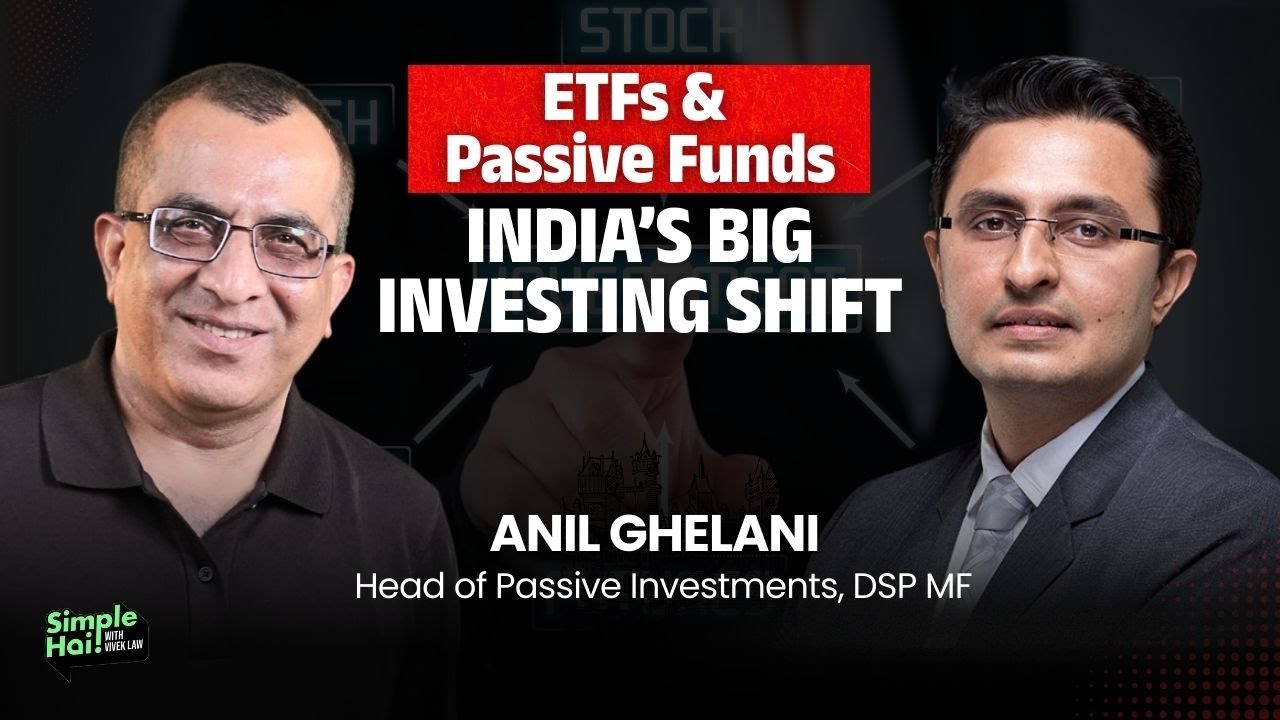
Anil Ghelani, CFA, Head of Passive Investments & Products at DSP Mutual Fund, joined Vivek Law on the Simple Hai! show to discuss active & passive investing, the rise of index funds and ETFs, and why simplicity and cost-efficiency are driving passive fund adoption in India.
In a recent interview with Anil Ghelani, CFA, Head of Passive Investments & Products at DSP Mutual Fund, veteran finance journalist Vivek Law, co-founder of the Simple Hai! show, explored the evolving landscape of investment strategies in India. From the debate between active and passive funds to the growing popularity of index funds and ETFs, Ghelani shared valuable insights on how investors can build balanced, cost-efficient portfolios.
Understanding Active and Passive Funds
Law began by asking about the difference between active and passive funds, since many investors often find the terms confusing. Ghelani explained that active funds rely on fund managers and research analysts to pick stocks in an attempt to outperform a benchmark index. Passive funds, in contrast, simply track a benchmark such as the Nifty 50, replicating its returns and risks without active intervention.
To make the concept relatable, Ghelani drew an analogy. He compared passive funds to a simple office thali, consisting of roti, dal, sabzi, and rice, which is reliable, straightforward, and inexpensive. Active funds, he said, are like dining at an Italian or Chinese restaurant: potentially more rewarding but also more specific and costly.
Active vs Passive: Complementary, Not Competing
When Law pointed out that discussions often frame active and passive strategies as opposing approaches, Ghelani emphasised that the debate should not be “active versus passive” but how both can complement each other. He suggested that passive funds serve well as the “core allocation” of a portfolio because of their transparency, simplicity, and low cost. Active funds, on the other hand, act as “alpha generators” for investors willing to take selective risks. According to him, a balanced portfolio that combines the broad exposure of passive funds with the targeted opportunities of active funds is the best way to maximise long-term returns.
Global Popularity of Passive Funds
When Law asked why passive funds are more popular abroad, especially in the US? Ghelani explained that in the US, ETFs and index funds have existed for decades, supported by tax advantages and higher investor awareness. Passive funds there offer low cost, tax efficiency, and simplicity, making them attractive compared to higher-fee active funds with inconsistent performance. In India, though tax benefits are limited, passive funds are gaining traction due to their cost-effectiveness and clarity on the risk-return profile.
Cost Differential in India
Law then asked about the cost difference between active and passive funds in India. Ghelani shared that direct index funds cost between 0.1% and 0.4%, while regular plans cost around 1%. In comparison, active funds charge 1.75% to 2% for regular plans and 0.75% to 1% for direct plans. He stressed that beyond cost, the simplicity of passive funds makes them particularly appealing to investors.
Advice for Beginners
Ghelani recommended that beginners start with passive funds that track broad indices, such as the Nifty 50 or Nifty 500. Calling it a “no-brainer,” he said such funds capture India’s economic growth in a simple and low-cost manner. He advised beginners to keep things straightforward by starting with two funds and expanding gradually as financial goals become clearer. Multi-asset or balanced funds may require greater understanding and professional guidance, he added.
Portfolio Diversification and Complexity
Law highlighted that some experts believe portfolios should hold multiple stocks to generate alpha, but questioned whether holding too many stocks dilutes this advantage. Ghelani agreed that owning hundreds of stocks through indices like the Nifty 500 essentially delivers market returns, leaving little room for outperformance. He suggested that the future may lie in rule-based strategies within broad indices, where a subset of objectively selected stocks could outperform the overall market.
ETFs and Commodity Exposure
On the subject of ETFs, Law asked about their role in commodities like gold and silver. Ghelani recalled that gold ETFs were once dominant, forming nearly 90% of the ETF market in India. While equity and fixed income ETFs are now more common, gold and silver ETFs still play an important role in diversification. He highlighted silver as particularly interesting, since nearly 58% of its demand comes from industrial use, adding a unique growth angle. He recommended ETFs as the best route for investors seeking commodity exposure, due to their transparency, liquidity, and efficiency.
A Personal Insight
Law also touched on Ghelani’s calm demeanour despite the high-stress nature of his profession. Ghelani credited his ability to stay grounded to the principle of simplicity, both in investing and in life. He said he preferred consistent, home-cooked meals and likened stress management to being a bridge rather than a dam, allowing challenges to flow beneath instead of bottling them up. Ethical work culture and alignment with colleagues, he added, also contributed to his peace of mind.
At the end of the interview, Ghelani appreciated Vivek Law for the great work he is doing on the Simple Hai! show, noting that it’s impressive how he is able to break down complex investment concepts into simple, easily understandable insights for viewers.
This episode featured practical insights from Ghelani, who underscored the importance of combining active and passive strategies rather than treating them as rivals. He highlighted the low cost, transparency, and accessibility of passive funds, especially for beginners, while acknowledging the role of active funds in generating alpha. With ETFs expanding beyond equities into commodities like gold and silver, India’s passive investment landscape is evolving rapidly. Ghelani left listeners with a clear framework for building sustainable, long-term portfolios.
Leave a Reply